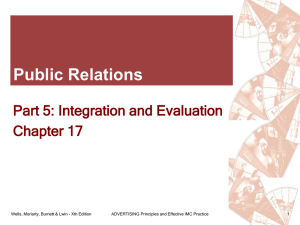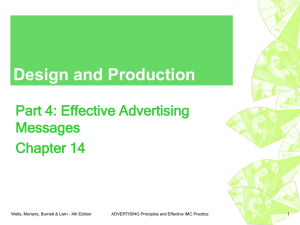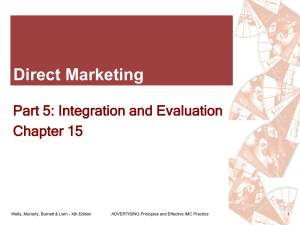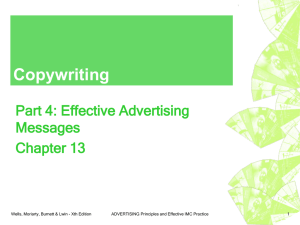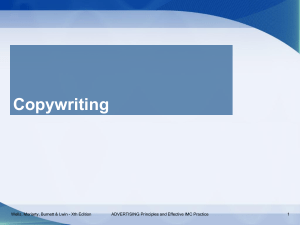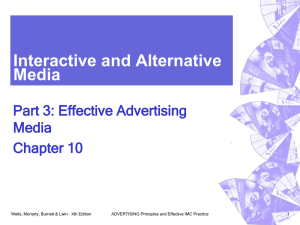Facets of Message Strategy
advertisement
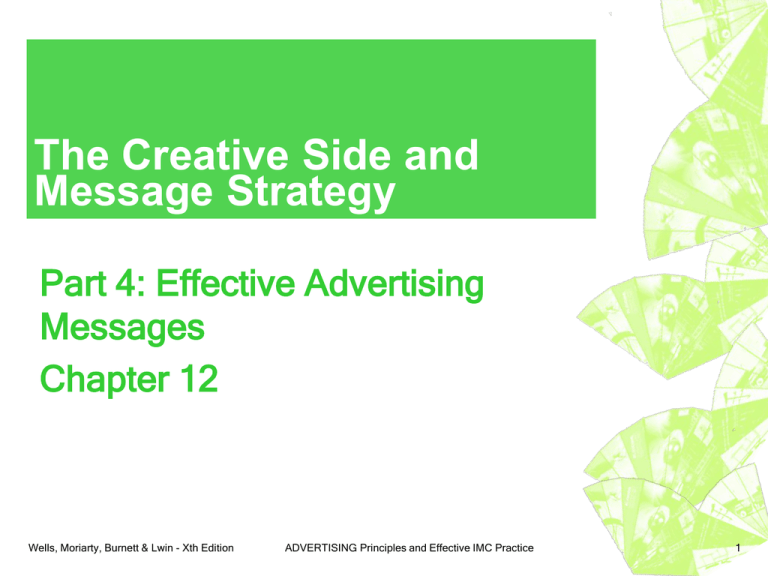
The Creative Side and Message Strategy Part 4: Effective Advertising Messages Chapter 12 Wells, Moriarty, Burnett & Lwin - Xth Edition ADVERTISING Principles and Effective IMC Practice 1 Key Points Define creative advertising and explain how it leads to a Big Idea Describe the characteristics of creative people and their creative process Discuss key creative strategy approaches Outline the key parts of a creative brief Wells, Moriarty, Burnett & Lwin - Xth Edition ADVERTISING Principles and Effective IMC Practice 1-2 The Art & Science of Creative Advertising Creative ad: fresh, unexpected, unusual ad The ROI of effective advertising Relevant: means something to the target Original: one of a kind Impact: ad gets attention & sticks in memory Wells, Moriarty, Burnett & Lwin - Xth Edition ADVERTISING Principles and Effective IMC Practice 1-3 The Big Idea or Creative concept Implements the advertising strategy so that the message is both attention getting and memorable Expressed visually and verbally Wells, Moriarty, Burnett & Lwin - Xth Edition ADVERTISING Principles and Effective IMC Practice 1-4 Examples: Creative Idea (Big Idea) Colgate: keep the good breath Darlies: gives freshness Pepsodent: keep the teeth whitest Wells, Moriarty, Burnett & Lwin - Xth Edition ADVERTISING Principles and Effective IMC Practice 1-5 Head and Heart Strategies Two basic creative strategies Rational Approach/Hard Sell: touches the mind and creates a response based on logic e.g. tangible product feature(benefits) Emotional Approach/Soft Sell: uses emotional appeals or images to create a response e.g. attitude, mood, dream, feeling Wells, Moriarty, Burnett & Lwin - Xth Edition ADVERTISING Principles and Effective IMC Practice 1-6 Tangible and Intangible Features Ad Objective Big Idea Wells, Moriarty, Burnett & Lwin - Xth Edition ADVERTISING Principles and Effective IMC Practice 1-7 Creative Strategy Creative strategy =Message Strategy What the advertisement says Creative execution How it is said Wells, Moriarty, Burnett & Lwin - Xth Edition ADVERTISING Principles and Effective IMC Practice 1-8 Message Objectives 1. Perception: create attention, awareness, interest, recognition, and recall 2. Cognitive: deliver information and understanding 3. Affective: touch emotions and create feelings 4. Persuasion: change attitudes, create conviction and preference 5. Transformation: establish brand identity and associations 6. Behavior: stimulate some form of action Wells, Moriarty, Burnett & Lwin - Xth Edition ADVERTISING Principles and Effective IMC Practice 1-9 Facets of Message Strategy 1. Drive Perception (attention getting +memorable) Attention and awareness Stopping power Interest: keep attention Pulling power Teaser ad Memory Repetition Jingle, Slogan, Color Wells, Moriarty, Burnett & Lwin - Xth Edition ADVERTISING Principles and Effective IMC Practice 1-10 Facets of Message Strategy 2. Drive Cognition These messages get consumers to learn about products by focusing on a product’s features (give info.) Differentiation Claim, Infomercial (Long copy approaches) Wells, Moriarty, Burnett & Lwin - Xth Edition ADVERTISING Principles and Effective IMC Practice 1-11 Facets of Message Strategy 3.Touch Emotions Highlight psychological attraction of the product to the target audience through emotional responses e.g.love, fear, pride, freedom etc. A general emotional goal is to deliver a message that people like in order to create liking for the product (like ad like product) Wells, Moriarty, Burnett & Lwin - Xth Edition ADVERTISING Principles and Effective IMC Practice 1-12 Facets of Message Strategy 4. Persuade (believe) Consumer committed to something., prefer it, probably intend to buy it Appeal: Psychological of product Conviction Testimonial; Test result; Before-after visual; Demonstaration, Endoesement, Product placement Wells, Moriarty, Burnett & Lwin - Xth Edition ADVERTISING Principles and Effective IMC Practice 1-13 Facets of Mesage Strategy Types of Selling Premises A proposition on which an argument is based or a conclusion is drawn O Benefit strategy: translate features and attributes into promise of what product can do for consumers e.g. gasoline economy O Promise: a benefit statement to show consumer about future rewards from using products e.g insurance co., whitening product O Reason why: show the reason for buying e.g. cheap O Unique selling proposition: a promise that consumer will get a unique benefit by using this only one product -It must be one that other product cannot or does not offer -It must be strong enough to pull over new customers to the brand e.g. Clinic Clear shampoo Wells, Moriarty, Burnett & Lwin - Xth Edition ADVERTISING Principles and Effective IMC Practice 1-14 Facets of Message Strategy 5. Transform Product Branding Image advertising is used to create a representation in the customer’s mind Associations: a brand with a certain type of person, lifestyle, or other characteristic Wells, Moriarty, Burnett & Lwin - Xth Edition ADVERTISING Principles and Effective IMC Practice 1-15 Facets of Message Strategy 6. Drive Action A signature that serves to identify the company or brand Also serves as a call to action if it gives direction to the consumer about how to respond Reminding ad strategy Wells, Moriarty, Burnett & Lwin - Xth Edition ADVERTISING Principles and Effective IMC Practice 1-16 Message Approaches (message format/message formula) Straightforward :convey communication without any gimmicks, emotion, or special effects. Demonstration :focus on how to use the product or service. Comparison: Show consumer that our product is superior than others. Problem solving/Problem avoidance: Show problems and what products can do and help to avoid the problem e.g p/d stops Wrinkle Humor : get attention Slice of life: Like problem solution but in drama form. Spokesperson ( Endorsement) : Use celebrity, experts, etc. to show that they use our product. Teasers: mystery ads that don’t identify the product or deliver enough message to make sense but just for some period of time to create curiosity and appeals. Shockvertising: grab attention and generate buzz Wells, Moriarty, Burnett & Lwin - Xth Edition ADVERTISING Principles and Effective IMC Practice 1-17 Summary Creativity is the essence of effective advertising Creativity is the combination of the image and the copy (or either one)=message in the ad. Balance between creativity and commerciality is required. Wells, Moriarty, Burnett & Lwin - Xth Edition ADVERTISING Principles and Effective IMC Practice 1-18
